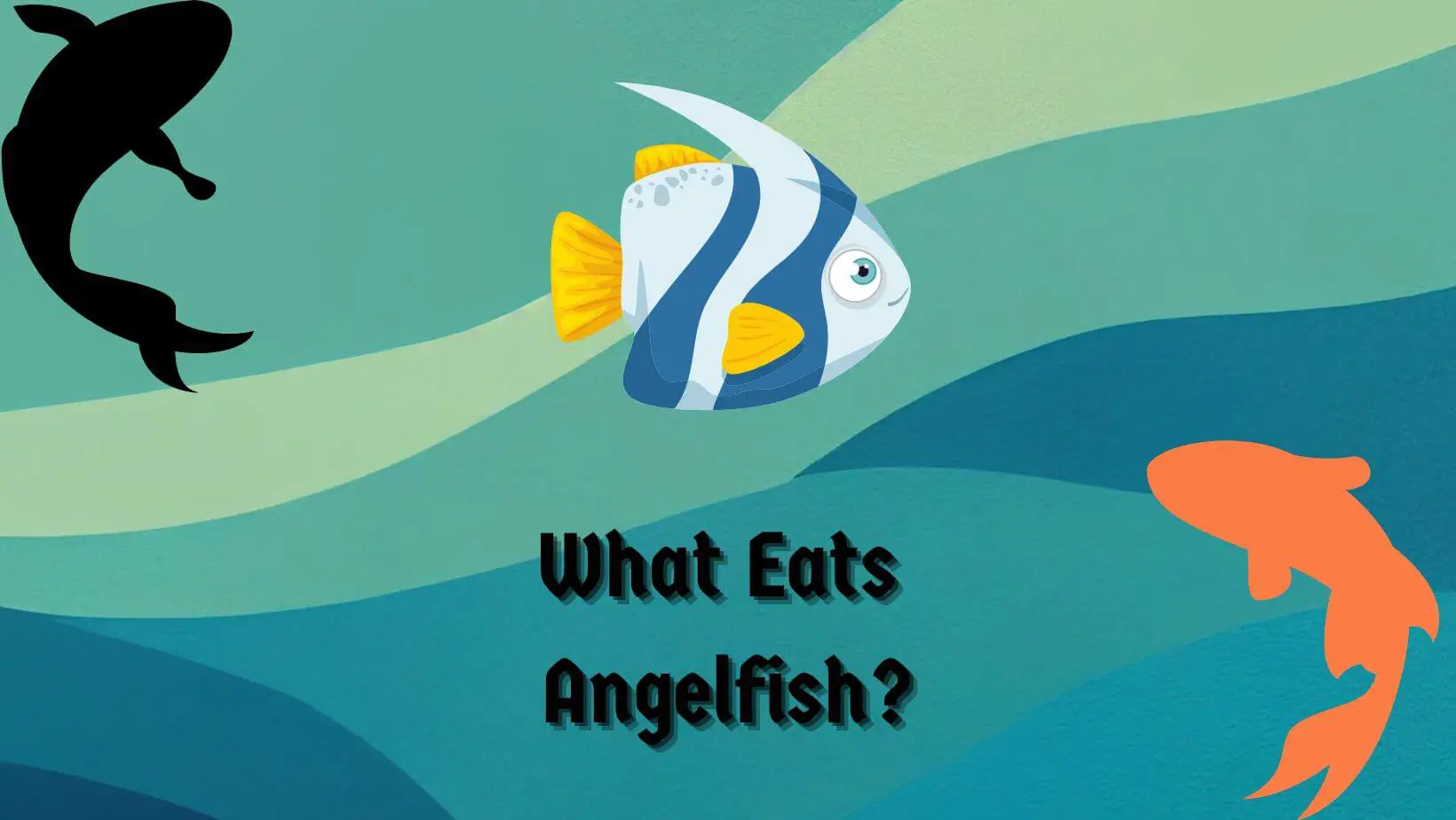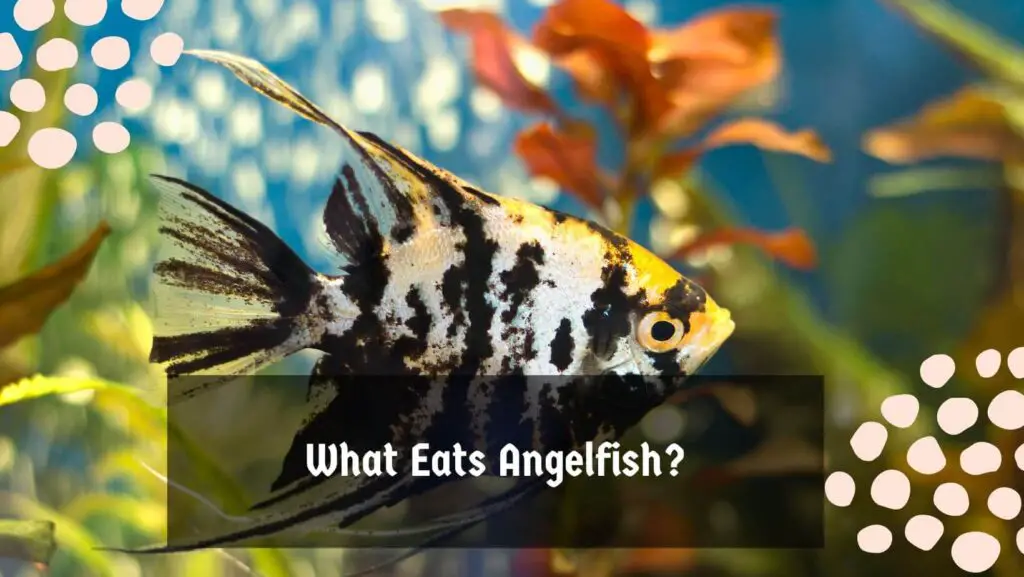
If you are an aquarium enthusiast like me, you might admire the vibrant color & graceful movements of angelfish. But looking at these fascinating creatures, you often wonder about their predators.
Indeed, angelfish face numerous challenges, including predation in the wild. Therefore, this article will discuss ‘what eats angelfish’ and their natural predating pattern for effective conservation and maintaining a healthy population.
If you want to explore the world of angelfish predators and explore aquatic, Avian & mammalian creatures that often prey upon this beautiful fish, read this article thoroughly.
What Eats Angelfish?

In the wild, angelfish often face numerous challenges, including predation from aquatic, avian & mammalian creatures. Some of the major predators of angelfish include pike cichlids, larger Tetra species, crayfish, shrimp, herons, egrets, otters, kingfishers, and a few other mammalian creatures like river dolphins.
Angelfish inhabit various natural habitats like rivers, streams, and lakes, where they coexist with creatures and Predators. To survive in this ecosystem, angel fish have also developed fascinating adaptations, including their body shape, coloration, and behavior to evade predation.
A study conducted by ResearchGate found that larger fish species often pose a significant threat to vulnerable angelfish populations in their natural environment. Cichlids, a diverse group of fish known for their aggression, have also been observed preying upon its species ‘angelfish.’
If you have ever owned one, you might know that they are known to display territorial behavior and often target smaller species of fish, including angelfish.
However, you should also note that the predation rate may vary depending on the specific species and the availability of alternative food sources. Now, it’s time to look at some of the most common aquatic, avian, and mammalian predators that often prey on angelfish.
Aquatic Predators
Tetras & Chichlids
The pike cichlid is the most notable angelfish Predator you will likely notice within their aquatic ecosystem. Pike cichlids are also very common aquarium pets known for their specialized hunting skills, using stealth & sudden burst of speed to capture their prey.
A study documented a specific predation habit of pike cichlids, further highlighting the angelfish preferences. The impact of the angelfish population can be significant, especially in an environment where these two species coexist nearby.
On the other hand, if you look at the largest species, like a silver dollar, you will also find them preying upon angelfish. Yes, kind of Tetras are known for their omnivorous diet and preferences for small prey, including angelfish.
There have been many instances where silver dollar Tetra has exhibited predatory behavior towards angelfish. The interaction between the larger fish species and angelfish predation is an intriguing area of research that requires further investigation for proper conservation & management of the angelfish population.
Another thing that we got to know after examining the interaction between angelfish & larger fish species in their natural environment is that angelfish can display distinct avoidance behavior in the presence of predatory cichlids or tetras.
This behavior may include seeking shelter among aquatic vegetation and staying close to submerged structures. Also, if you want to know about their adaptation, consider paying attention to both the species’ interaction & understand the significance of angelfish adaptation in mitigating the risk of larger fish predators.
If you want to know about the angelfish as freshwater fish & how they adapted, consider reading our article ‘are angelfish freshwater.’ Coming back to the point, now it’s time that we find out more about what eats angelfish.
Crayfish
Crayfish love preying on small invertebrates and fish using their claws & scavenging behavior. Crayfish can also prey on angelfish as they capture and consume smaller fish.
Even though angelfish are not considered a primary food source for crayfish, angelfish can still fall victim to crayfish predation if alternate food sources or prey are unavailable. Crayfish usually attack angelfish when they’re young or injured. This further underscores the vulnerability of angelfish to the hunting progress of crayfish.
Shrimp
Another common predator that often feeds on angelfish is said to be shrimp. Yes, larger shrimps have also been found preying upon angelfish in shared environments. You will find a significant correlation if you examine the diet of the largest shrimp species and their impact on the angelfish population.
Even though shrimps are known to feed on plant matter and detritus primarily, they may occasionally consume smaller fishes like angelfish. Also, you should know that the defense mechanism of angelfish, like its body shape & speed, plays a crucial role in reducing shrimp predation.
We have frequently noticed crayfish and shrimps consuming angelfish, particularly during periods of low food availability. This further finding highlights the complex dynamics between angelfish and freshwater shrimp. But, if you’ve ever wondered “Do Angelfish Eat Shrimp?“, check this out.
Avian Predators
After knowing about the aquatic predators of angelfish, we must understand the range of avian predators that threaten the angelfish population.
Herons & Egrets
Herons and egrets are majestic wading birds popular for their hunting prowess. These birds are known to have long slender beaks helping them to spear their prey. Even though herons and egrets’ primary diet consists of fish, it has been found that they also occasionally prey upon angelfish.
These birds have already exhibited references for shallow water habitats which often coincide with the natural habitats of angelfish. Therefore, it’s not uncommon for these birds to attack angelfish in such a habitat. Angelfish are more susceptible to predation or herons & egrets.
Kingfishers
Well, kingfishers are very popular for their predatory skill. They are known for their spectacular diving and fishing skills and are considered another avian predator group that occasionally includes angelfish in their daily diet.
However, you should know that the seasonal variations may also affect the angelfish predation by Kingfishers. Angelfish predation by kingfishers often increases when there is a high fish abundance period.
Also, you should note that the Angelfish population may experience sudden fluctuation due to the foraging pattern of kingfishers. More research is needed using GPS tracking devices to monitor the movement pattern of these kinds to observe their interaction with the angelfish population.
When we compare Kingfishers with other predatory Birds like herons and egrets, we find that Kingfishers are known to have a higher predation rate during the mid-day. On the other hand, kingfisher target angelfish during the early morning & afternoon.
Birds of Prey
Apart from herons, egrets & Kingfisher, we have also observed ospreys and eagles consuming angelfish infrequently. Even though raptors are known to target larger fish species primarily, there have been a few instances of Angel predation by these certain Birds.
However, a few factors may influence angelfish vulnerability to these kinds of prey birds, including habitat proximity, angelfish population density, and the ability of alternative food sources.
Suppose you investigate the predation pattern of birds of prey on angelfish in a lake ecosystem. In that case, you will witness the feeding behavior of ospreys & eagles, which constitute a small portion of small fishes, including angelfish in the diet.
Mammalian Predators
After knowing some of the most popular aquatic & avian predators, let’s take a quick look at some of the mammals that may attack angelfish & eat them. Generally, all these mammals are known to thrive in oceans. Still, some can also inhabit rivers, streams, & lakes. Therefore, let’s look at some mammalian predators to learn more about ‘what eats angelfish.’
Otters
You may know this, but others are not only popular as playful creatures but also as skilled hunters. If you pay attention to the primary diet of otters, you will find fish consisting of a major portion.
Otters have been seen consuming angelfish in specific habitats as well. Suppose you notice the predation behavior of otters and their impact on the angelfish population. In that case, you must consider otter predation when assessing the factors influencing the angelfish population in the natural environment.
The interaction between otters & angelfish in a river environment has always been complex. After researching other field observations and analyses presented by researchers, scientists, and Aquarist, I learned that otters selectively target larger angelfish because smaller individuals successfully invoke otter predation.
Larger Fish-eating Mammals
Apart from otters, there are also a few Marine animals, like dolphins or whales, which can be considered uncommon predators for angelfish. Researchers have documented occasional instances of angelfish predation.
Yes, this kind of instance is typically attributed to the opportunistic feeding behavior of these larger fish-eating animals. There are also a few types of dolphins & sharks that may rarely attack & consume angelfish if alternate food sources are unavailable.
However, you should also note that the migration pattern & habitat overlap often influence the rare cases of angelfish predators by dolphins, sharks, and whales. Even though angelfish predation by Marine mammals is very infrequent, it can still occur during periods of increased mammal activity or a high abundance of angelfish in a particular location.
Conclusion
After reading this article, I hope you know all the information on ‘What eats angelfish.’ I have given my best to give you a proper understanding of the predators & their Natural predation pattern of angelfish, which is essential for their conservation.
Here you have explored aquatic, avian, & mammalian predators that have been observed targeting angelfish. If you have gained valuable insights into the complex dynamics of this kind of ecosystem, consider sharing the article.
Make sure to maintain a healthy angelfish population near your water body by understanding their predators, their adaptation to avoid predators, and the interplay between predators & prey.
If you do proper research, you will continue to uncover the intricacies of angelfish predation and facts, paving the way for more effective conservation strategies you can implement & promote the long-term survival of these remarkable fish.
If you find this article helpful, consider sharing it. Your share will help many people learn ‘what eats angelfish’ and their adaptation to predation. It would help to remember that angelfish predation is a natural phenomenon, and there is nothing to be sad about.
Do check my other helpful guide on fun facts about angelfish or do angelfish eat other fish. See you in the next post, till then, take care & goodbye.

